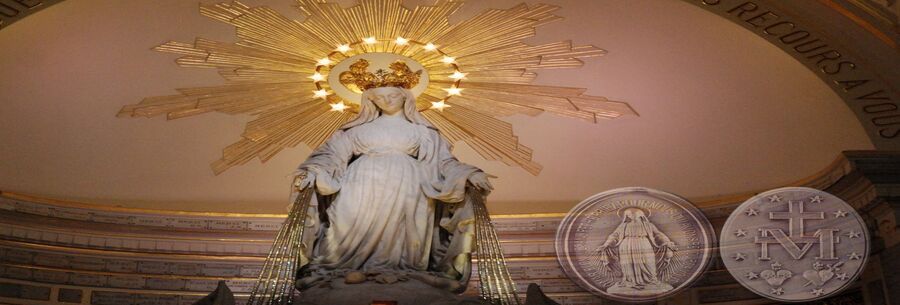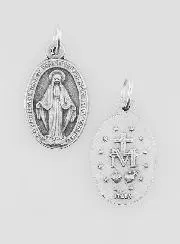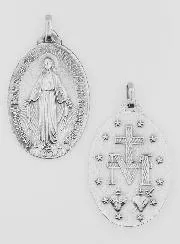The Miraculous Medal, one of the world's best-known Marian symbols, is much more than just a piece of religious jewellery. Created following the apparitions of the Virgin Mary to Saint Catherine Labouré in 1830, this medal embodies spiritual depth and a message of faith for those who wear it. Each element on the front and back of the medal has a precise meaning, representing essential aspects of the Catholic faith and Marian devotion. Let's explore in detail the meaning of the Miraculous Medal and what each side of the medal symbolises for believers.
Origin of the Miraculous Medal
Before detailing the symbols on the front and back of the medal, it's important to look back at its origin, as its history gives this sacred object a special significance. In 1830, Saint Catherine Labouré, a nun of the Daughters of Charity in Paris, received several apparitions of the Virgin Mary in her chapel on the Rue du Bac. During the second apparition, on 27 November 1830, the Virgin asked her to have a medal struck according to a very precise model, promising that all those who wore it with confidence would receive special graces. This promise by Mary is at the origin of devotion to the Miraculous Medal, the use of which has spread throughout the world.
The Front of the Medal: The Symbols and their Meaning
The front of the medal, or "recto", depicts an image of the Virgin Mary and several symbols that accentuate its spiritual significance.
The Virgin Mary standing on the globe: On the front of the medal, the Virgin Mary is depicted standing on the globe, symbolising her universal mission and kingship over the world. Her position also indicates that she is a protective figure, watching over humanity. She is sometimes depicted crushing a snake beneath her feet, symbolising her victory over evil and her role in the redemption of humanity, by participating in Jesus' saving mission.
The outstretched arms and rays of light: The Virgin's arms are open and stretched downwards, a gesture of welcome and benevolence towards humanity. Rays of light stream from her hands, symbolising the graces she bestows on all those who ask her for them. During her apparition, Mary is said to have explained to Saint Catherine that these rays represented the graces that God grants through her, as Mother of all believers. The rays also show Mary's role as mediatrix of divine graces, able to guide souls to God.
The inscription: "O Mary conceived without sin, pray for us who have recourse to you": This phrase surrounds the image of the Virgin Mary on the front of the medal. It refers directly to the dogma of the Immaculate Conception, which proclaims that Mary was conceived without original sin, a unique grace granted by God in view of her mission as Mother of the Saviour. This prayer implores Mary to pray for those who "have recourse to her", underlining faith in her intercession with God. The inscription also reminds believers that by turning to Mary, they gain access to a path of mercy and purity.
Together, these elements on the front symbolise Mary as a protector of humanity and a source of graces, ready to intervene with God on behalf of his children. It also reminds believers of the importance of the Immaculate Conception, as well as Mary's maternal and universal love.
The Reverse of the Medal: The Symbols and Their Meaning
The reverse side of the medal, or "verso", is equally rich in symbols and profound meanings.
The cross and the "M": In the centre of the rear panel is the letter "M" topped by a cross. The "M" represents Mary, while the cross is the symbol of Jesus Christ's sacrifice for humanity. The union of the letter "M" and the cross symbolises the inseparable link between Mary and Jesus' mission of redemption. Mary, as the Mother of Christ, shares in his sufferings and spiritually participates in his Passion. The cross over the "M" also embodies Mary's fidelity in her mission as Mother of the Church and in her unfailing support for believers.
The two hearts: Beneath the cross and the "M" appear two hearts, each with its own characteristics. The first heart, surrounded by thorns, is the Sacred Heart of Jesus, symbolising his infinite love and sacrifice for humanity. This heart is also a reminder of the suffering and Passion of Jesus, who was willing to suffer for the salvation of the world. The second heart, pierced by a sword, represents the Immaculate Heart of Mary. It evokes the prophecy of Simeon, who announced to Mary that a sword of pain would pierce her heart (Luke 2:35), in reference to the suffering she would endure on seeing her son crucified. Together, these two hearts embody the sacrificial love of Jesus and the compassion of Mary, an invitation for believers to meditate on suffering and divine love.
The twelve stars: Around the "M", the cross and the two hearts, you can see twelve stars arranged in a circle. These stars represent the twelve apostles and, by extension, the universal Church founded on their teachings. They also symbolise Mary's vision as "Queen of Apostles" and "Queen of Heaven", a title given to her in Catholic tradition. The twelve stars also refer to the vision in the Apocalypse of Saint John, where a woman appears with a crown of twelve stars (Revelation 12:1), interpreted as Mary by the Church. This symbol underlines Mary's role as Mother of the Church and protector of the faithful.
The Overall Spiritual Significance of the Miraculous Medal
The Miraculous Medal is a concentrate of symbols that expresses the great principles of the Catholic faith: the protection and love of Mary for humanity, her role of intercession with God, and the sacrificial love of Jesus Christ. Wearing the medal is therefore an act of faith, a constant reminder of Mary's benevolent presence in the lives of believers, and a call to follow her example of devotion and purity. By praying with this medal, believers are invited to contemplate the mysteries of divine love, to meditate on the Passion of Jesus and to entrust themselves to Mary, knowing that she is interceding with God. For many of the faithful, the medal is seen as a sign of grace and blessing, a means of receiving Mary's spiritual help in difficult times.
The Miraculous Medal As a Tool of Protection and Grace
Beyond its theological significance, the Miraculous Medal is also worn as a sign of spiritual protection and closeness to the Virgin Mary. Since its creation, numerous testimonies have attributed special graces and miracles to the medal, including physical cures, conversions and protection from danger. This link between the medal and spiritual protection is reinforced by Mary's words to Saint Catherine Labouré, promising that all those who wear the medal with faith will receive great graces. Believers who wear the Miraculous Medal thus express their trust in Mary's promise and show their attachment to her as their spiritual Mother. They see the medal as a constant reminder of their faith and of Mary's maternal love, which watches over them and guides them to God.
The Miraculous Medal, through its symbols and message, is a spiritual treasure for millions of Christians. The elements on the front and back of the medal represent profound truths of the Catholic faith: the love of Jesus, the compassion of Mary, the power of prayer and the mission of the Church. Wearing this medal is not only an act of faith, but also a way of uniting spiritually with Mary, who intercedes for her children with infinite love.




















